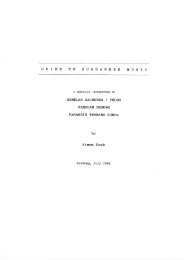Wet rice cultivation in Indonesia - Free EBooks Library
Wet rice cultivation in Indonesia - Free EBooks Library
Wet rice cultivation in Indonesia - Free EBooks Library
You also want an ePaper? Increase the reach of your titles
YUMPU automatically turns print PDFs into web optimized ePapers that Google loves.
<strong>Wet</strong> <strong>rice</strong> <strong>cultivation</strong> <strong>in</strong> <strong>Indonesia</strong> Chapter two<br />
Both community irrigation systems were organised on a relatively small scale. The largescale<br />
public irrigation systems that were <strong>in</strong>troduced by the Dutch were often created on the<br />
same place where community based irrigation systems existed. Therefore, we will<br />
concentrate on these public systems below.<br />
2.4.3 The development of public irrigation systems<br />
Introduc<strong>in</strong>g the colonial public irrigation system <strong>in</strong> the early 20 th century, the Dutch<br />
essentially focused on two issues. Firstly to <strong>in</strong>crease the production per hectare, and<br />
secondly to <strong>in</strong>crease the national <strong>rice</strong> production as such. Below, we will review this <strong>in</strong> more<br />
detail. The creation of the first Dutch irrigation systems dates much earlier however.<br />
Accord<strong>in</strong>g to Pelzer, the construction of the first system took place <strong>in</strong> Buitenzorg (now<br />
Bogor) <strong>in</strong> the period of Governor General van Imhoff (1743-1750). He also writes that until<br />
the early 20 th century, these endeavours were of extremely limited proportions. Most of the<br />
1.27 million hectares that were irrigated <strong>in</strong> the 18 th century were either under village<br />
irrigation systems or merely ra<strong>in</strong>fed (Pelzer, 1945).<br />
The reasons for the Dutch to start large-scale public irrigation systems were foremost<br />
important to <strong>in</strong>crease trade. Under the liberal oriented economic policy – adopted after 1870<br />
– foreign estate companies began leas<strong>in</strong>g land for <strong>cultivation</strong> of exports crops (such as<br />
sugar, <strong>in</strong>digo and tobacco), <strong>in</strong>clud<strong>in</strong>g some that required guaranteed supplies of water. The<br />
small-scale village based irrigation as described above, were simply not appropriate for<br />
large-scale <strong>cultivation</strong> due to their technical <strong>in</strong>adequacies (Booth, 1977a).<br />
The new policy of the Dutch was also a ‘modernisation mission’, <strong>in</strong> which modern<br />
technology played a central role. Improv<strong>in</strong>g people’s welfare was thus a second aim of this<br />
policy (Ravesteijn, 2002:134). Indeed, <strong>in</strong> the course of time irrigation became one of the key<br />
factors of the modernisation mission of the Dutch.<br />
Dur<strong>in</strong>g the first half of the 19 th century, Dutch eng<strong>in</strong>eers started construct<strong>in</strong>g irrigation works<br />
by creat<strong>in</strong>g dams <strong>in</strong> rivers that already had a connection to irrigation works. Often these<br />
works replaced the small-scale communal irrigation systems (see the section above) or<br />
those constructed by the local colonial adm<strong>in</strong>istrators, with the help of forced labour. The<br />
works constructed by the colonial authorities, though larger than the traditional structures,<br />
were just as vulnerable and so cont<strong>in</strong>uous renovation and reconstruction was necessary.<br />
We can expla<strong>in</strong> this by the fact that eng<strong>in</strong>eers used the same materials as rural<br />
communities. Gradually they <strong>in</strong>troduced more durable materials such as brick and concrete<br />
(Ravesteijn, 2002:131). Just as rural communities ga<strong>in</strong>ed experience by trial and error many<br />
centuries ago (see also section 2.3.1), the Dutch eng<strong>in</strong>eers faced exactly the same<br />
problems, but on a larger scale. Consequently, the possibility of us<strong>in</strong>g new materials and<br />
technologies made the difference for the creation of large-scale irrigation systems.<br />
In the period between 1800 and 1885, modern irrigation works rema<strong>in</strong>ed relatively scarce.<br />
Consider<strong>in</strong>g the quality of these works there were improvements because of the utilisation of<br />
new materials. Steadily construction activities <strong>in</strong>creased and <strong>in</strong> 1890, they ga<strong>in</strong>ed a def<strong>in</strong>ite<br />
form with the <strong>in</strong>troduction of the General Irrigation Plan for Java. The plan covered n<strong>in</strong>eteen<br />
projects and another seven projects were added to the plan later (Ravesteijn, 2002:133).<br />
This makes clear that the creation of large irrigation systems not only implies access to<br />
durable materials and technologies, but also a function<strong>in</strong>g <strong>in</strong>stitutional system that facilitates<br />
the practical implementation. We will explore this <strong>in</strong> more depth below.<br />
To mark out the most suitable way of irrigation management, the colonial government<br />
established a commission <strong>in</strong> 1904. There were two proposed options based on the practices<br />
that took place <strong>in</strong> the field. The first option was based on the predeterm<strong>in</strong>ed yearly cultural<br />
plan, which consisted of two major components, namely the cropp<strong>in</strong>g system and the water<br />
distribution plan. The cropp<strong>in</strong>g system plan refers to the arrangement of the crops with<strong>in</strong> an<br />
19








